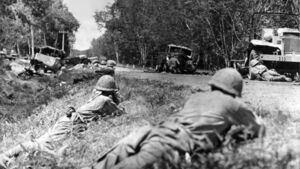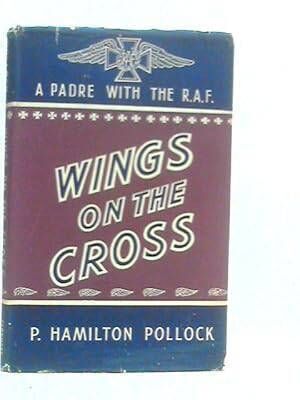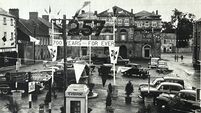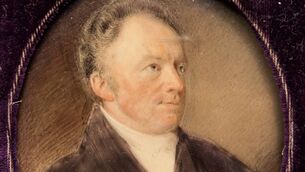The Athy men who fought in WWII

The Battle of Malaya. Dr Gerry O’Neill was serving as a Major in the British Army in Malaya when in January 1942 the Japanese invaded
A SIMPLE ceremony enacted in a canvas tent on the heath at Lüneburg in Germany in May 1945 marked the end of World War II in Europe when Germany formally surrendered to the allied forces.
Back in neutral Ireland the Irish people went about their business as usual. In the coalmining town of Castlecomer a young garda sergeant and his family were preparing to move house yet again.
He had done this four times since getting married, but this was to be the last occasion of packing furniture and belongings into a hired lorry to journey to a new town.
The garda sergeant was my father, John Taaffe, who in May 1945 brought my mother Kathleen and her five young sons to Athy. The transfer was at his request, as he could get his sons into a secondary school where none were supposed to be had in Castlecomer. The short journey to Athy ended at No. 6 Offaly Street in a two-up two-down terraced house rented from Myles Whelan, and it was not until 1954 that the Taaffes moved into No. 5 Offaly Street.
May 1945 of course was more momentous for those men of Athy who found themselves scattered across the world, fighting in the war. Among them was Joe ‘Lowly’ Walsh from Barrack Street, Athy.
The son of master tailor Joseph Walsh and Teresa Byrne, at the outbreak of World War II Joe ‘Lowly’, like many Athy men, called to the local garda station to enlist in the Irish army. When I interviewed him almost 30 years ago, his abiding memory of the three years he spent in the Irish Army was what he recalled was “the scandalous army food”.
Conditions in the army were so bad that there was almost wholesale desertion by many disenchanted recruits who travelled by train to Belfast to join the British Army.
‘Lowly’ followed that same path and in 1942 he joined the RAF. He served in France, Belgium and Holland as a member of the Motor Transport Light Repair Unit.

He passed through Caen in France where he recalled that even the graveyards had been destroyed by bombing. He eventually ended up in Berlin where he stayed two weeks in the city which had hosted the Olympic Games in 1936.
He also recalled visiting the Reich Chancellery where Hitler had committed suicide in his bunker in May 1945.
Other Athy men were further afield such as Dr Gerry O’Neill, the third son of Dr Jeremiah O’Neill of Mount Offaly House, Athy.
Gerry was serving as a Major in the British Army in Malaya when in January 1942 the Japanese invaded. After being cut off from his unit with five other British soldiers, Gerry spent almost three and a half months trekking through 2,000 miles of dense undergrowth and dangerous jungle trying to reach the British lines in Singapore.
Captured by the Japanese, Gerry subsequently spent three and a half years incarcerated in appalling conditions, with his incarceration only ending in August 1945 with the surrender of Japan.
His story is one of enormous courage, barely hinted at in the headlines of the local newspapers on his return to Athy following his release, ‘Back from the Grave – Athy man’s terrible ordeal.’ Not all those who went to war returned.
Two grandsons of John Holland of Model Farm, Athy were lost. Major Nigel Holland, fighting with the 4th/5th Maharatta Light infantry, Indian Army, was killed in Burma in June 1944 at the age of 25 years.
Sergeant William Holland served in the Royal Air Force, died in Italy at the age of 19 years of age in 1945. Both are commemorated in St Michael’s Cemetery, Athy.
Another Athy man, Terence H.K. Hosie of the Royal Engineers, was killed in action in Italy in 1943 and he is remembered in the Presbyterian Church on the Dublin Road, opposite the old St Michael’s Cemetery.
It is unfortunate that the service of the Athy men in World War Two is little recorded and I have yet to come across a published account of any Athy man’s service in the war.
The closest thing we have to that is the , published by Fr Philip Pollock. Fr Pollock was instrumental as a Dominican Father, based in Athy, in the commissioning, design and construction of the modern architectural gem, St Dominic's (now the town library). Prior to coming to Athy, he had served as a chaplain, with the Royal Air Force in England, North Africa, Sicily and Italy recounting his war experiences in his bestselling book.
For Fr Pollock the end of the war was a time of reflection. In his final chapter he wrote: ‘The horrors of the North African campaign came back vividly to his mind as he thought of the wounded lying in military hospitals. They would not be celebrating V.E (Victory in Europe) night but would be remembering the day they were wounded. Yes, V.E night was a night of memories.’ Just a reminder that the annual famine commemoration ceremony will take place in St Mary’s Cemetery (opposite St. Vincent’s Hospital) on Sunday, 18 May at 3pm. All are welcome.





